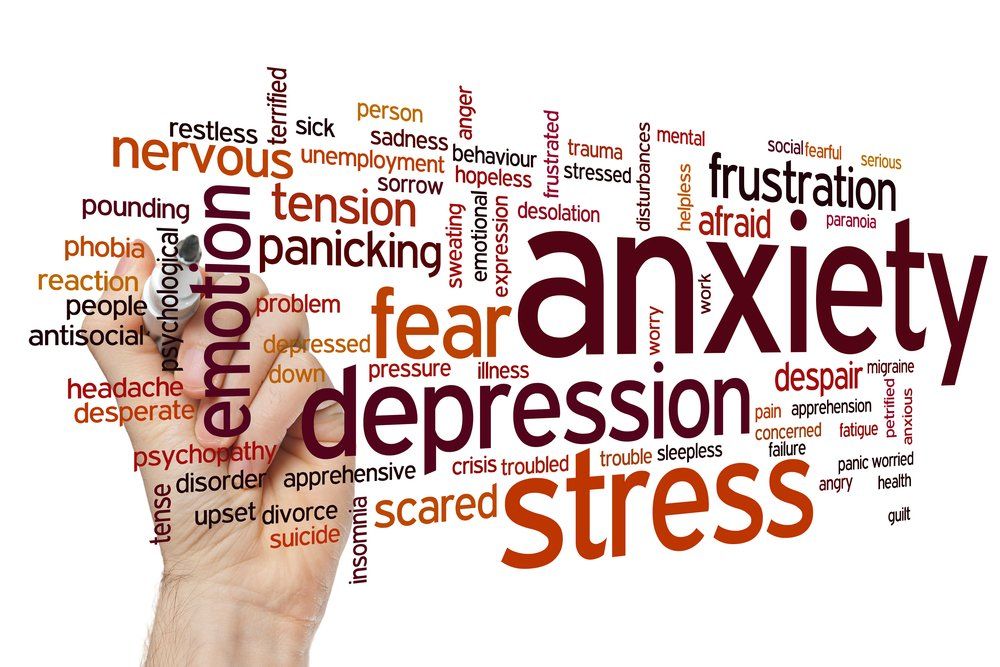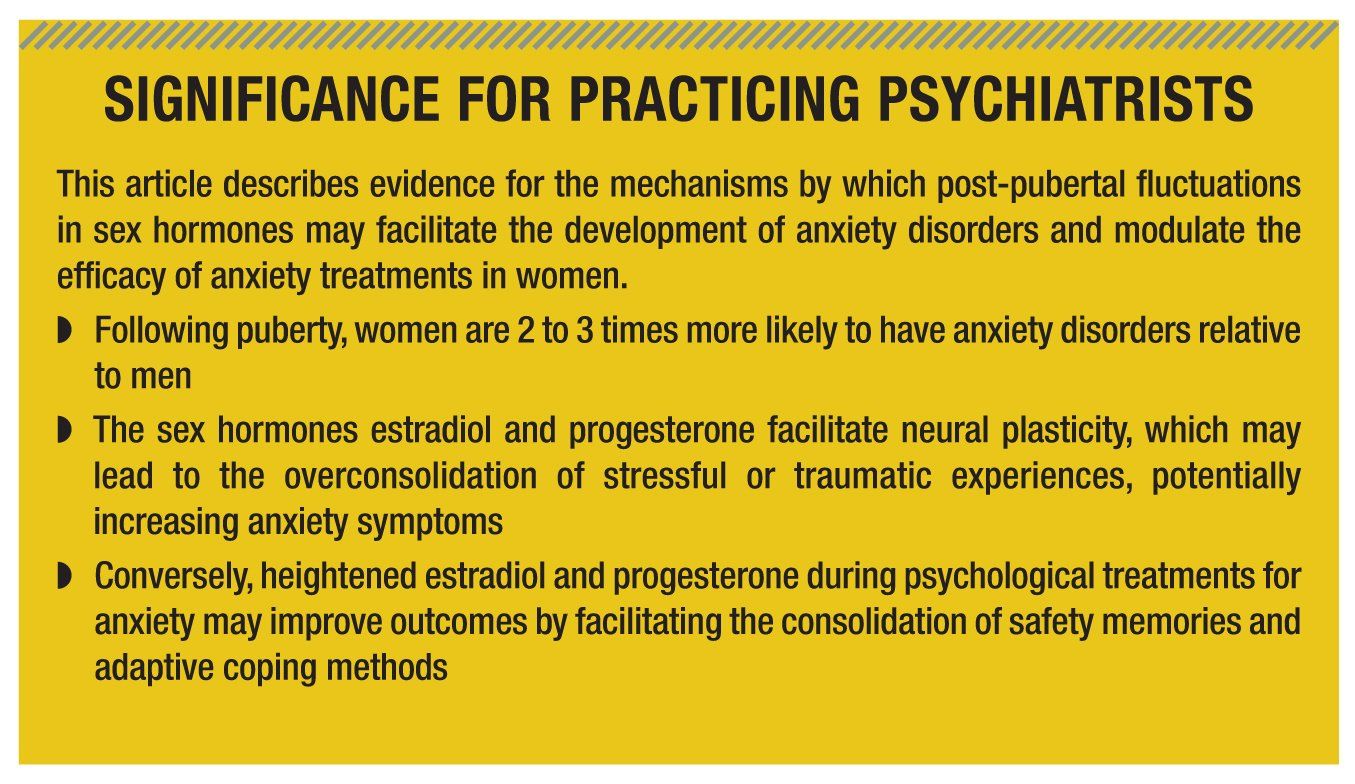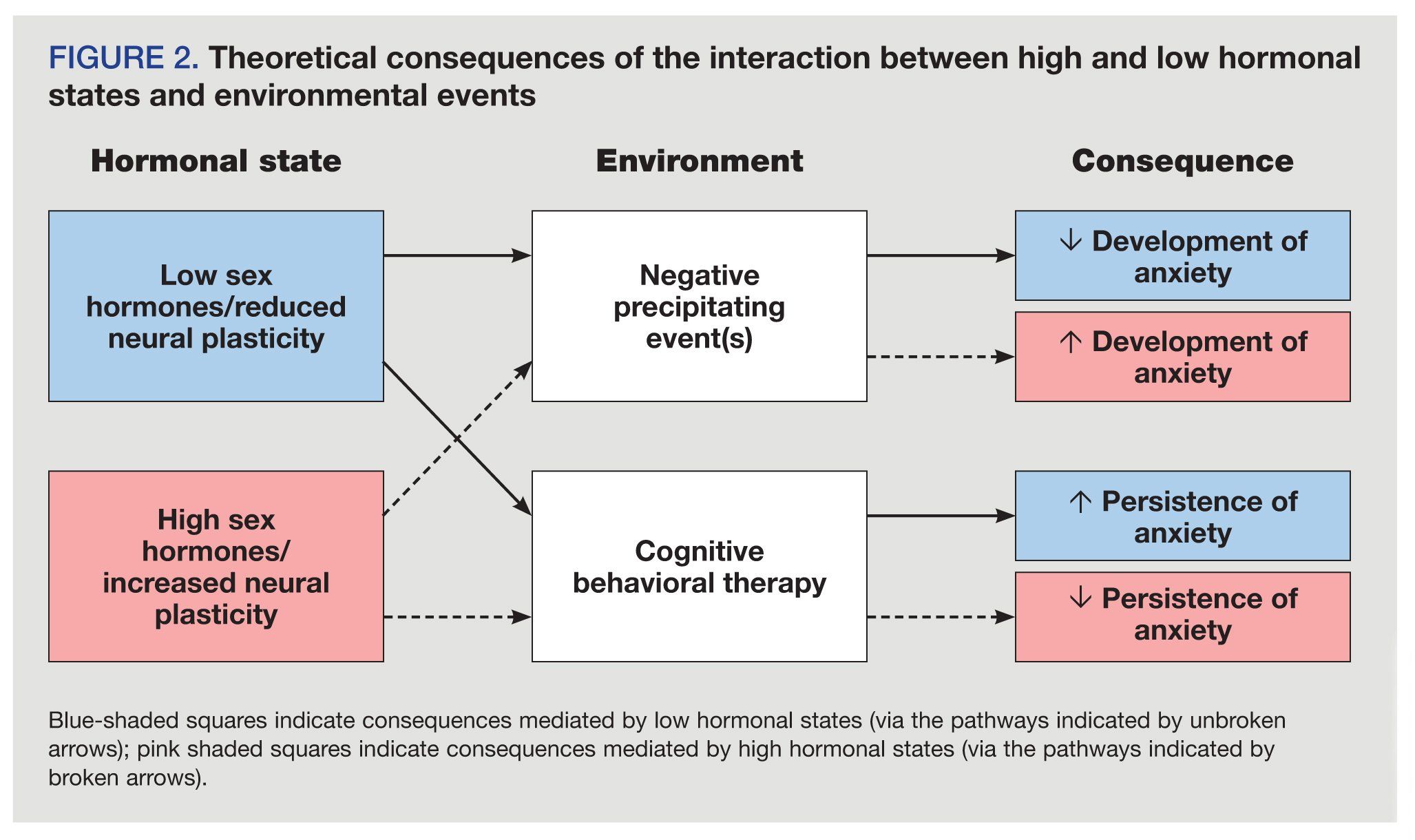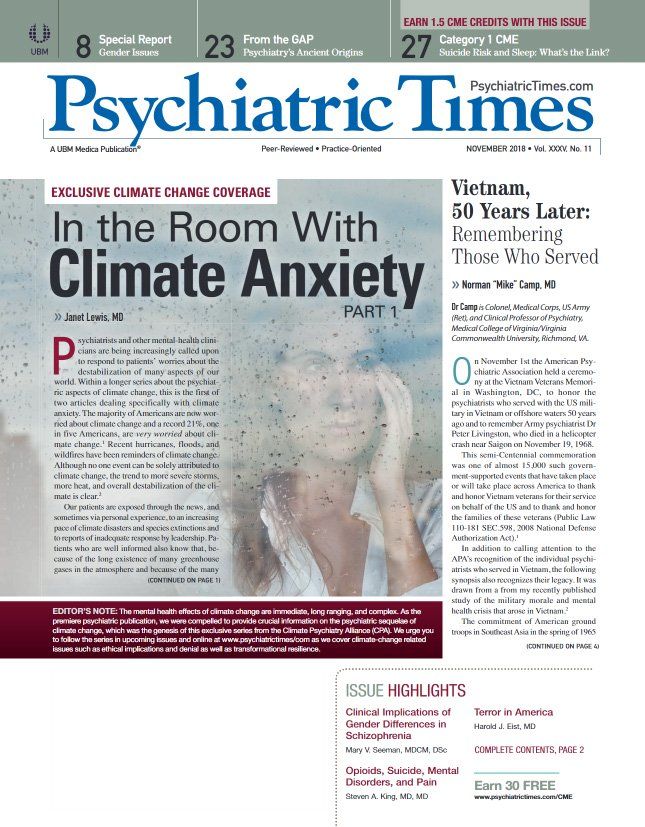Publication
Article
Psychiatric Times
Sex Hormones and Gender Vulnerabilities to Anxiety Disorders
Clinicians can help raise awareness of the role of sex hormones in persistent anxiety by integrating 5 considerations into their practice.
Lculig/Shutterstock.com

SIGNIFICANCE FOR PRACTICING PSYCHIATRISTS

A cognitive behavioral model of anxiety disorders

FIGURE 2. Theoretical consequences of the interaction between high and low hormonal states and environmental events

Large-scale mental health surveys have consistently shown that the prevalence of anxiety disorders and related conditions is approximately 1.5- to 2-fold higher in women than it is in men.1,2 Despite similar patterns that occur across all anxiety subtypes, this sex difference appears most pronounced for PTSD, generalized anxiety disorder, and specific phobias.
Although the sex imbalance in the prevalence of anxiety disorders is undisputed, debate surrounds its source. Social and environmental factors undoubtedly contribute to the imbalance, for example: men may be less inclined to report anxiety symptoms because of stigma. The socioeconomic status of men and women is often different. Thus, their daily stressors are also different as is their ability to access coping resources. Although men and women may experience trauma similarly, there are stark differences in the nature of these traumas, with sexual assault (itself a strong risk factor for PTSD) being 10 times more prevalent among women.3
Apart from environment, the neurobiology of men and women also differs substantially. Responsible for many of these differences is sexually divergent gonadal sex hormone synthesis, with the male testes primarily producing testosterone and the female ovaries primarily producing estradiol (the main estrogen) and progesterone. Apart from minor diurnal fluctuations, postpubertal males have relatively steady levels of testosterone throughout their adult lives, followed by age-related declines. In contrast, postpubertal females experience dynamic fluctuations in estradiol and progesterone on a monthly basis due to the menstrual cycle and across the lifespan due to hormonal contraceptive use, pregnancy, parturition, and menopause.
Sex differences in the prevalence of many anxiety subtypes do not emerge until puberty. Similarly, women exhibit increased vulnerability to anxiety during the postpartum and perimenopause periods, times of substantial hormonal flux. Sex differences in hormone exposure and stability may exacerbate women’s risk for anxiety by interacting with the putative factors that underlie the pathogenesis of anxiety.
Why do anxiety disorders develop and persist over time?
Cognitive-behavioral models posit that genetically vulnerable individuals react in maladaptive ways to negative or stressful precipitating events that trigger the onset of anxiety symptoms (Figure 1). Several key factors subsequently prevent anxiety from spontaneously remitting. In brief, anxious individuals grossly overestimate the likelihood and the consequences of potential threat in a given situation. These catastrophic predictions fuel the physiological and affective symptoms of anxiety, thereby promoting the use of maladaptive behavioral coping strategies, most notably avoidance. Avoidance precludes the individual from acquiring corrective information about the true level of threat in the situation. Thus, the catastrophic cognitions (and in turn, the anxious symptoms) are maintained.
Cognitive behavioral therapy (CBT), the first-line psychological treatment recommended for anxiety disorders, disrupts this self-perpetuating cycle by modifying catastrophic thoughts. CBT comprises exposure therapy, in which the patient is taught to confront anxiety-eliciting situations without engaging in avoidance tactics, and cognitive restructuring, in which the patient collects evidence from multiple sources, including conducting his or her own experiments, to test the validity of (and ultimately undermine) catastrophic beliefs.
Role of sex hormones in persistent anxiety
Aside from their key role in reproduction, sex hormones (in particular, estradiol) facilitate neural plasticity, including initiation of intracellular signaling cascades, gene transcription, and growth of dendritic spines and synapses. This occurs in both females and males-many of testosterone’s actions in the brain result from its aromatization to estradiol.4 Because of cyclic fluctuations in sex hormones, postpubertal females exhibit substantial basal changes in key markers of neural plasticity in brain areas involved in memory formation.
Neural plasticity is essential for learning as well as the formation of new memories-including the learning that occurs during exposure to stressful or traumatic events, and the safety learning that occurs during CBT for anxiety. It is possible that different sex hormone levels create a state of neural plasticity that is more or less permissive for the formation of both kinds of memories. We have proposed a two-pronged model, wherein the consequences of fluctuating neural plasticity in women may differ depending on what is happening in the external environment at the time (Figure 2).5
In brief, high sex hormone levels (and resulting increases in brain plasticity) during stress or trauma may facilitate over-consolidation of these experiences, thereby increasing the propensity to develop anxiety disorders. Conversely, once anxious symptoms have developed, high sex hormones may be beneficial during CBT by facilitating the formation of new safety memories and more adaptive means of coping.
Laboratory and clinical studies provide initial support for the central hypotheses in this model. Results from studies have demonstrated that intrusive recollections (a key symptom of PTSD) of traumatic images and films are stronger in women during periods of high sex hormones.6 Women who experienced traumatic injury during a high hormonal menstrual phase reported more numerous negative flashbacks in the subsequent week compared with women who experienced traumatic injury during a low hormonal phase.7 Women who accepted emergency contraception (which suppresses sex hormonal synthesis) following sexual assault reported reduced post-trauma reactions relative to women who refused emergency contraception.8
In relation to the hypothesis that higher sex hormones may be beneficial to CBT, a decade of research has established that sex hormones, particularly estradiol, modulate fear extinction, the laboratory analogue of exposure therapy.5 In brief, females exhibit better extinction (reduced fear responses) when exposed to anxiety-provoking stimuli during periods of high, relative to low, estradiol.
In both males and females, pharmacologically blocking estradiol impairs, and administering estradiol facilitates, extinction. In females, hormonal contraceptives (which suppress sex hormones) impair extinction. In the first translation of these laboratory findings to a clinical setting, we demonstrated that the success of exposure therapy for spider phobia was correlated with women’s endogenous estradiol levels during treatment.9
Women with higher estradiol progressed through treatment more rapidly and exhibited greater posttreatment reductions in spider avoidance and self-reported phobic symptoms, relative to those with lower estradiol. Of note, women using hormonal contraception (who had the lowest estradiol) showed the poorest treatment response.
Role of sex hormones in fluctuations in anxiety symptom severity
In addition to potentially modulating the development and persistence of anxiety symptoms, fluctuating sex hormones are also associated with changes in anxiety symptom severity. Increases in symptom severity have been observed during periods of declining or low sex hormones in women with panic disorder, social anxiety disorder, PTSD, and obsessive-compulsive disorder, which share clinical features of anxiety.5
Although it is unclear what mediates this effect, it is known that women report maladaptive coping strategies more so than do men. One possibility is that women may alter the types of coping strategies that they use depending on their levels of sex hormones. For example, women report increased use of avoidant coping styles during the premenstrual phase (declining sex hormones).
The impact of a given coping strategy may also differ dependent on sex hormones. Although women tend to ruminate (a maladaptive coping strategy) more during periods of high estradiol, the negative impact of rumination on mood has been found to occur only in women with low estradiol.10 Hormone-associated instability in coping strategies may further exacerbate anxiety by decreasing women’s ability to self-control symptoms.
Practical considerations for screening, diagnosis, prevention, and treatment
Our understanding of the role of sex hormones in anxiety in women, while increasing, is in its infancy. Current psychobiological models of anxiety (which drive innovations in anxiety treatments) are biased in favor of males because of a preponderance of studies solely focused on male rodents and human studies inadequately powered to assess for sex differences. Regardless of whether the sex imbalance in the prevalence of anxiety disorders is primarily driven by reporting biases, or non-organic factors, female variables such as menstrual cycle and hormonal contraception, which have been historically ignored, are likely relevant to the pathogenesis and treatment of anxiety.
New mandates requiring the consideration of sex as a biological variable in research funding applications may foster a more-nuanced understanding of the relevant sex-specific factors to consider when making diagnostic and treatment decisions for anxiety disorders.
In the meantime, clinicians can help to raise the profile of this important issue, and make use of the existing research base, by integrating the following considerations into their practice:
1 Conduct an assessment of the onset and exacerbation of anxiety symptoms in relation to hormonal events (eg, use of hormonal contraction, menstrual cycle, pregnancy, parturition, perimenopause); consider changing/removing hormonal contraception if a link is established.
2 Routinely provide psychoeducation to increase women’s awareness of a potential link between hormones and anxiety, both following symptom onset and pre-emptively (eg, in patients about to experience significant hormonal change, such as preadolescents, before starting hormonal contraception, and in pregnant women and perimenopausal women).
3 For patients with anxiety disorders, encourage incorporation of menstrual cycle phase (or other hormonal events) in routine monitoring of symptom fluctuation. This may increase the sense of control over symptoms by facilitating predictability and fostering targeted use of adaptive coping strategies during identified times of heightened vulnerability.
4 Consider timing exposure therapy during periods of optimal hormonal levels. Women on hormonal contraception may require more-extended treatment sessions to achieve benefit. Note that this consideration is based on one clinical study on specific phobia, however, and the utility of this approach for other anxiety disorders awaits more extensive empirical investigation.9
5 Women’s tendency to engage in maladaptive coping styles is well established. This should be a focus of attention during clinical assessment of women. Women may especially benefit from targeted cognitive interventions for anxiety (eg, rumination-focused CBT) that directly correct these maladaptive coping styles.
Disclosures:
Dr Graham is Associate Professor, Clinical Psychology, School of Psychol ogy, University of New South Wales, Sydney,Australia.
Dr Graham reports no conflicts of interest concerning the subject matter of this article.
References:
1. McLean CP, Asnaani A, Litz BT, Hofmann SG. Gender differences in anxiety disorders: prevalence, course of illness, comorbidity and burden of illness. J Psychiatr Res. 2011;45:1027-1035.
2. Slade T, Johnston A, Oakley Browne MA, et al. 2007 national survey of mental health and wellbeing: methods and key findings. Aust N Z J Psychiatry. 2009;43:594-605.
3. Altemus M, Sarvaiya N, Neill Epperson C. Sex differences in anxiety and depression clinical perspectives. Front Neuroendocrinol. 2014;35:320-330.
4. Garcia-Segura LM. Aromatase in the brain: not just for reproduction anymore. J Neuroendocrinol. 2008;20:705-712.
5. Li SH, Graham BM. Why are women so vulnerable to anxiety, trauma-related and stress-related disorders? The potential role of sex hormones. Lancet Psychiatry. 2017;4:73-82.
6. Ferree NK, Kamat R, Cahill L. Influences of menstrual cycle position and sex hormone levels on spontaneous intrusive recollections following emotional stimuli. Conscious Cogn. 2011;20:1154-1162.
7. Bryant RA, Felmingham KL, Silove D, et al. The association between menstrual cycle and traumatic memories. J Affect Disord. 2011;131:398-401.
8. Ferree NK, Wheeler M, Cahill L. The influence of emergency contraception on post-traumatic stress symptoms following sexual assault. J Forensic Nurs. 2012;8:122-130.
9. Graham BM, Li SH, Black MJ, Ãst L-G. The association between estradiol levels, hormonal contraceptive use, and responsiveness to one-session-treatment for spider phobia in women. Psychoneuroendocrinol. 2018;90:134-140.
10. Graham BM, Denson TF, Barnett J, et al. Sex hormones are associated with rumination and interact with emotion regulation strategy choice to predict negative affect in women following a sad mood induction. Front Psychol. 2018;9:937. â







